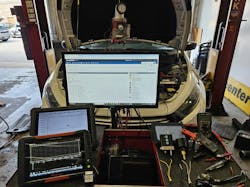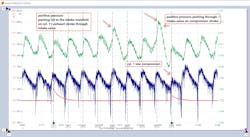Any good professional has their own arsenal of tools to get their job done quickly and efficiently. The same thing goes for us technicians and diagnosticians. Some of you may have one built already and some of you may be just getting into building one and that's ok because today is your lucky day. I am going to share my diagnostic inspection tool arsenal with you.
I'm sure most techs will be able to relate to this situation — a vehicle comes in with a single-cylinder misfire. Pretty routine, right? You open the hood and, oh no, it's a Nissan 3.5 liter and the intake manifold is covering the back three cylinders. Are we going to pull the intake manifold off and swap the plugs and ignition coils, put it back together, and see if the misfire moved? Some technicians might. Im here to show you a way to figure it out without taking anything apart besides a fuse. Wait what just a fuse? This brings me to the first tool in my diagnostic arsenal — the PicoScope.
This tool allows you to see exactly what's going on with a component electrically and mechanically, displayed on a screen with voltage over time. If we look at Figures 1 and 2, I have two different lab scopes being used. We see the vehicle with the single cylinder misfire and can see the current flow from all six ignition coils just by interfacing a low amp probe from AESwave to the vehicle via the fuse that feeds the ignition coil's power. From that, we can deduce the problem — a bad ignition coil. By utilizing these tools, we determined the issue quickly, efficiently, and most importantly, without removing the intake manifold.
Pressure transducers
This is a perfect segway into the next tool in my line-up — pressure transducers, such as the WPS500X from Pico Technology. Have ever you had a mechanical problem on an engine that you were not sure if it was a bad valve, lifter, or camshaft and only tearing the engine down would show the problem? Great news, we have a better way to justify engine tear-down time. By hooking up a pressure transducer to the intake manifold coupled with a high amp probe to the battery and voltage lead going to the PicoScope, we can crank the engine over and see the mechanical health of the engine.
In Figure 3, you can see the blue trace; we have current flow from the starter which directly relates to the compression strokes of the engine. The red trace will be the control voltage to the ignition coil, which tells us what cylinder is firing and when, and the green trace, which is my favorite part, shows the pressure in the intake manifold. With good practice, you can analyze what is wrong with this engine. We have positive pressure pushing into the intake manifold on cylinder 1's compression stroke via cylinder 1's intake valve showing that the intake valve is not sealing. This test takes only five minutes to set up, and time is money, baby.
The test light
Another one of my favorite tools to use when diagnosing electrical problems is the test light. Test lights come in many forms and fashions such as incandescent test lights, which can draw up to 450 mA of current flow, or LED test lights, which draw about 50 mA of current flow. There are endless possibilities of what we can do with these test lights, but one specific example comes to mind.
A vehicle comes in on a hook with a crank with a no-start issue. We find ourselves at the fuel pump relay with our handy-dandy test light testing power and control to the relay. Now we need to know about the feed wire to the fuel pump. Most of the time we would have to drop the fuel tank to access this wire. However, with our test light, we can switch the lead to battery positive and lightly touch the pin of the feed wire to the fuel pump (Figure 4). If the light lights up we know the wire and fuel pump circuit are electrically intact all the way from the fuel pump to the ground.
Another quick and efficient way to use a test light, specifically an incandescent test light, is by hooking it up to the battery or chassis ground, then we can activate a lower current flow device, like a relay, to bypass the control for that device.
Scan tools
It all starts with a scan tool. Scan tools come in all shapes and sizes and are a technician's first line of defense. This is where you can quickly gather data and put together a diagnostic direction, all from the comfort of the driver's seat. One tip I can give you about scan tools, and this goes for most scan tools, is if you customize your data PIDs down to only the ones that relate to the issue, your refresh rate will be much faster, making it easier to find your direction for the repair. I feel that this is the most important job of the scan tool — to find which road of testing you need to go down.
One of my favorite scan tools is the eSCAN Elite from Automotive Test Solutions. This scan tool allows you to pull DTCs and look at Mode 6 data and misfires. It also has its own arsenal of guided tests for dynamic testing. For example, it has a fuel trim sharpshooter test that allows you to drive the vehicle with the scan tool test function open to this test (Figure 5) and will fill in a fuel trim chart of various engine loads making easy to see where your fuel trim issue lies. That is one of many dynamic tests this scan tool has to offer, as well as a catalytic converter test, volumetric efficiency test, and many more.
Conclusion
In closing, we have only scratched the surface of how to efficiently use the tools in your diagnostic inspection tool arsenal. I can give countless examples of the many ways to use these tools to our advantage. In this business, we definitely need the higher ground. Vehicles are not getting any easier to work on. However, I believe if we practice and utilize the tools to the best of our ability, there is not a problem out there that we cannot handle.
Also, if you are just starting out in this business, it takes time to build this arsenal of tools and learn how to optimize them. Do not get discouraged. Slowly build this arsenal one tool at a time if you have to.
One more point to add before I get back to doing what I love to do, diagnosing vehicles, there is always something new to learn, vehicles are advancing at a rapid rate, and we have to do the same. You know that saying practice makes perfect? Well, we might never be perfect but we can get pretty dang close.
Tools used
- PicoScope from Pico Technology
- Low Amp Probe from AESwave
- WPS500X Pressure Transducer from Pico Technology
- LED Test Light
- Incandescent Test Light
- eSCAN Elite from Automotive Test Solutions
About the Author

Rick Urso
Rick Urso has been in the automotive industry for over 20 years. Currently, he works at a family-owned shop, Hi-Tech Auto Specialists in the southwest suburbs of Chicago. Urso started out sweeping the floors and worked his way up to lead technician, then to store manager. He runs the shop while diagnosing most of the drivability and electrical problems that come through. Urso notes that their shop takes pride in doing good, honest work and diagnosing problems correctly the first time.





